
For many families, sitting down to watch a favourite Rankin-Bass special is holiday tradition. The stop-motion and animated worlds this company created are classic, as beautiful in their artifice and integral to the spirit of the season as the tinsel on a Christmas tree. But as much as we all love the films of Rankin-Bass, I bet you haven’t seen… all of them.
You might be shocked. Because you don’t know. “I’ve seen Frosty the Snowman!” you’re thinking. Okay, great. But you’ve never seen The Little Drummer Boy: Book II. You’ve never seen The Leprechaun’s Christmas Gold. Yet for some insane reason, I’m thinking we all might be missing out. So, to properly celebrate our first Christmas with Rogues Portal this year, I’m going to go through as many Rankin-Bass movies as I can until we hit that special day on the 25th.
Today we begin with the special that started it all: Rudolph the Red-Nosed Reindeer!
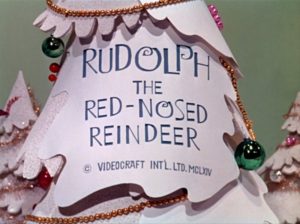
While it’s known for its groundbreaking use of stop-motion animation, Rudolph the Red-Nosed Reindeer actually opens with a live action segment consisting of black and white stock footage and newspaper headlines. Augmented with an ominously dramatic version of the title song, the scene has the look and feel of a movie newsreel. The reference is old even for 1964, Rankin-Bass already courting those feelings of nostalgia that will help their works endure for decades to come. This scene is only 22 seconds long, but it leaves a lasting impression. There’s a sense of history to these images now, a gritty neo-realism that evokes the memory of every child’s first bitter snowstorm. Yet directly following this grounded take, we immediately enter the comforting, colourful world that is Rankin-Bass. The transition is as seamless as coming in from the snow and being offered a warm mug of hot chocolate. You welcome it with open arms.
Burl Ives is the first of many Rankin-Bass narrators, and his Sam the Snowman is a paternal figure that proves the mechanism will continue throughout nearly every Rankin-Bass special to follow. His warm, comforting vocal style makes him the perfect actor for the part. His versions of Holly Jolly Christmas or Silver and Gold just feel right for the Christmas season, and he welcomes you in from that bitter snowstorm to a place where most children will form their most idyllic views of winter.
Yet Christmas only really starts with a child being born in what can recognisably be described as a manger. Here Rudolph is the infant swaddled in straw, and only a brief moment of contentment occurs in this new family unit, when all is disrupted by a significant and unacceptable genetic deviation: Rudolph’s nose is glowing red.
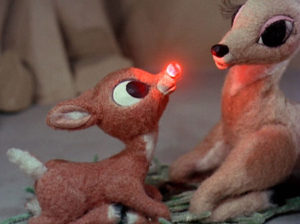
This moment is important, and really coloured the rest of my viewing in a new light, so I want to linger on it for longer than I normally would. The distraught tone and body language of his parents is unmistakable. It sends a message of perception that all of our primary adult figures throughout the first half of this special share. There’s something wrong with Rudolph’s body.
There’s metaphors for ableism here, to be sure. Maybe even body dysmorphia. Keep in mind that the male character of Rudolph is actually voiced by Billie Mae Richards, a prolific Canadian radio actress, and you can see how a reading can be made of this film being a parable for the struggles of a trans or nonbinary child and their challenges in dealing with society. I have doubts that Romeo Muller ever intended this when he wrote Rudolph the Red-Nosed Reindeer, and it may be simply the idea of being a misfit is so prevalent in our current social climate that parallels could be drawn in any direction, but I can’t let go of the injustice in the perception of Rudolph’s physical wrongness. From birth, Rudolph is rejected and told to cover up, hide away his shining nose, and hope it’s just a phase. He’s denied the chance to live as his true authentic self.
In any case, the light up nose is a great effect.
It’s here in the manger that we also get our first proper introduction to Santa as a thin man in a red-brown coat and cap. This is a very human version of Santa. We’re on his home turf, he doesn’t need to be ‘on’ the same way he is Christmas night, and I like the idea of Santa milling around the North Pole in something that will keep him warm rather than a costume. Rudolph the Red-Nosed Reindeer is able to present a more real version of the classic character, which is perfect, since he’s far more flawed as well. In all honesty, he’s kind of a dick. Don’t get me wrong, Jingle Jingle Jingle is a minute full of joy, but of all people, you would hope that Santa at least would allow Rudolph to accept himself as he is. Instead, he’s just as disparaging as the newborn’s clearly phobic parents.
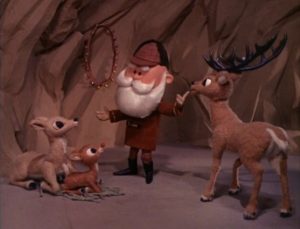
In a secondary storyline of this opening section, we see the inner workings of Santa’s Workshop, where elves make toys for boys and girls to open on Christmas morning. Only not all elves want to make toys, most notably Hermey. Of course! He’s another misfit. They do it by making him want to be a dentist, something intensely normal. Only it’s not the same as Rudolph’s physical issues. Instead, Hermey has ambitions of rising above his social station, he wants to be a dentist. It’s a class struggle, dare I say possibly even a race struggle, as it appears all “elves” are expected only to do grunt work or entertain the privileged members of the Claus family through song and dance. Look at the way his ambition is rebuffed by the other elves, this is clearly a societal problem!
Cutting back to the reindeer games, we again see how Old Donner is a staunch traditionalist. If the word “old” in Sam the Snowman’s description didn’t tell you that, his actions soon will. The first half of this film features so many characters that evangelise conformity. Rudolph doesn’t get to play any reindeer games, literally shunned because of the difference in his own body. Why are the elves all bald? Santa doesn’t like this song and so far, I don’t like the systematic problems inherent in his community.
The relationship between Clarissa and Rudolph gives this film its prerequisite love story. This sequence is charmingly heterosexual, and I would have loved to bear witness to the recording booth where these two women sang it to each other. Sadly, it’s a love that’s seemingly not to be, as Rudolph’s nose again becomes an obstacle. Not even in itself this time, but in Rudolph’s now fully-molded perception that it should be. Society has taught him to hate himself.
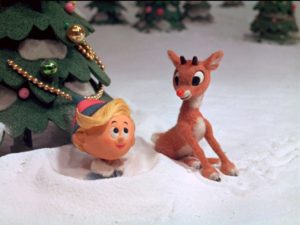
Hot off the heels of this rejection, Rudolph finds Hermey in the snowbank. The two recognise each other instantly in We’re a Couple of Misfits (although some versions of this special will have the pair singing about Fame and Fortune instead) and they’re pals for life. Fun fact: the 1998 film Bram Stoker’s Shadowbuilder would later reunite Billie Mae Richards and Paul Soles (the actors who played Rudolph and Hermey) to play opposite each other as husband and wife. If you’ve ever wanted to see Hermey take an axe to Rudolph, you’ve found your new favourite film.
Cornelius is an oddity within this narrative for me. A prospector obsessed with either silver or gold depending on his mood, I’ve never actually understood what made this character a misfit. Are we talking about a sexual binary here? The way Cornelius seems determined to find gold one minute and silver the next? To be honest, it feels like a lot of his character was left on the cutting room floor. He may even be an ally to our intrepid adventurers, but I’d love to know more. His main purpose is in granting the pair safe passage from the North Pole to parts unknown. The one thing I will say is that we don’t talk about Cornelius’ dogs enough. Those are some cuties.
Rudolph, Hermey, and Cornelius end up at the most iconic location of this special: The Island of Misfit Toys. Here on the Island of Misfit Toys, the trio find what they deem to be a paradise: an entire community built on misfit-ism. Yet as non-toys themselves, our trio is excluded. You can look at this isolationist community much in the same way as those areas of marginalised communities that still discriminate against others, such as those communities driven by trans-exclusionary feminism.
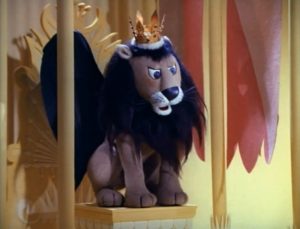
The toys tell Rudolph he needs to speak with King Moonracer. I love this guy. It’s like the writers had been carefully stepping on ice to make sure they didn’t get too outside the comfort zone of the original series, then just decided to drop in a lion-headed griffin. In Narnia, the lion was a Jesus figure, and I don’t think it would be too out of line to read King Moonracer in a similar light. Unlike problematic-Santa, Moonracer provides some worldly advice to the couple of misfits. “Unlike playthings, a living creature may not hide themselves away on an island”. It’s almost as if Moonracer knows the toys aren’t doing what’s best for themselves, but has no way of helping them himself. They want the freedom to live their lives, but only on their terms.
Cornelius and Hermey decide to leave together. For Rudolph, however, this is one rejection too many and he feels he’s holding his companions back. Instead, Rudolph leaves them. Queer youth are known to be at severe risk of homelessness and Rudolph is the quintessential representation of that fact. With unsupportive familial environments like Rudolph’s being a leading factor into sending this kids to the streets, Rudolph grows up on the fringes of society, finding only fleeting moments of happiness as he makes his own way.

He returns home to find his parents vanished. Santa informs him that they set out to find him months ago, but were lost to the Abominable Bumble. If we’re following our metaphors to their natural conclusion, the Bumble represents the toxic masculinity Rudolph must defeat in order to to “free” his parents and become accepted in their eyes. Yet when Rudolph faces this demon alone, he fails.
Why? You could argue the power of friendship, but I think it’s deeper than that, and in fact fairly integral to the overall theme of my take on this special. There’s a term called intersectionality which “holds that the classical conceptualizations of oppression within society—such as racism, sexism, classism, ableism, homophobia, transphobia, xenophobia and belief-based bigotry—do not act independently of each other.” Rudolph is oppressed for his physical difference by the same sources that oppress Hermey for his race. Only together are they able to defeat the Bumble and live the lives they want.
The end of the song has always struck me as leaving something to be desired. Rudolph is insulted and chastised by the entire community but is then redeemed solely because he is useful? What sort of message is that? Thankfully, Rankin-Bass agree and do some work to correct this fact without betraying the origins of the story. Here, Rudolph steps up to work out his own issues, and only then even attempts to return to the community. By doing so, it’s not a matter of Rudolph being accepted because he is useful, but that the prior discrimination was unfair. As Sam the Snowman says, “even Santa realises that maybe he was wrong.”
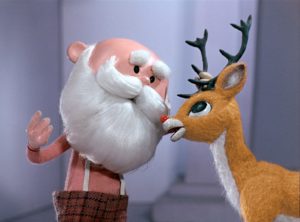
It’s a neat bow, but in ways it still falls short. Fully confident and accepting of himself, Rudolph flies proud and confidently alongside the other reindeer as an equal on Santa’s team. There are no compromises to be made in how Rudolph chooses to express the differences in his body. The fact that those differences make him “special” is… something to think about. It is a bit of a trope I’ll get into on another day, but it’s also probably due to the fact that none of this was intended at all, and I’m just reading way too much into a children’s show.
Since Rudolph the Red-Nosed Reindeer is the first film in the Rankin-Bass holiday franchise, I don’t really have much choice as to its placement. It gets top spot for now. I wouldn’t be surprised if it stayed there, but I liked digging into the meat of this first special.
- Rudolph the Red-Nosed Reindeer (1964)
I didn’t actually expect to read so deeply into the queer themes and intersectional aspects as I did, but once I started thinking about them, I found a layer to this film that simply hooked me into thinking deeper about its meaning. I likely won’t be able to keep up the pace to make each of these articles this long if I want to finish twelve films by Christmas, but I am satisfied by this end result.
Next Up: The Little Drummer Boy!
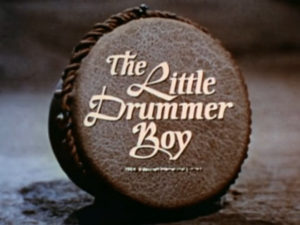




2 thoughts on “Rudolph the Red-Nosed Reindeer: Misfits, Representation, and Intersectionality”